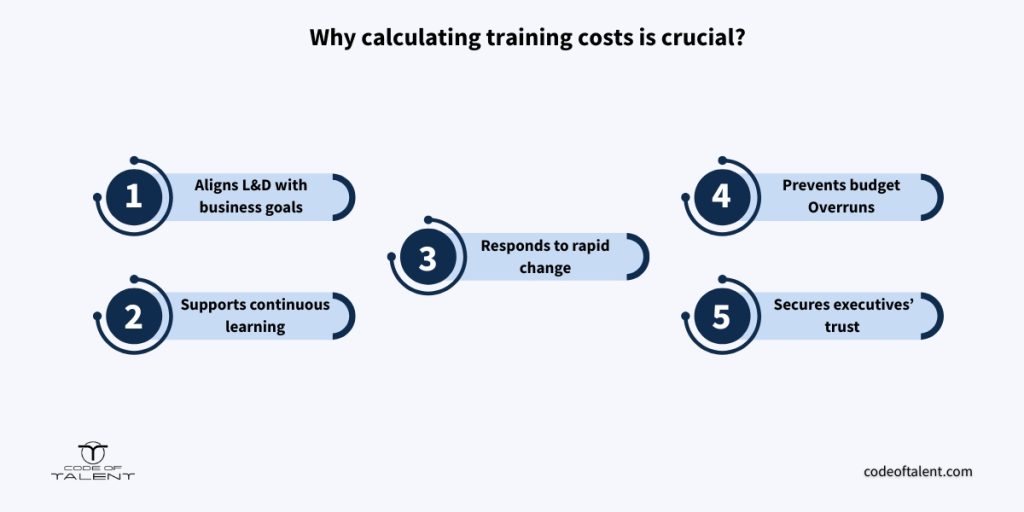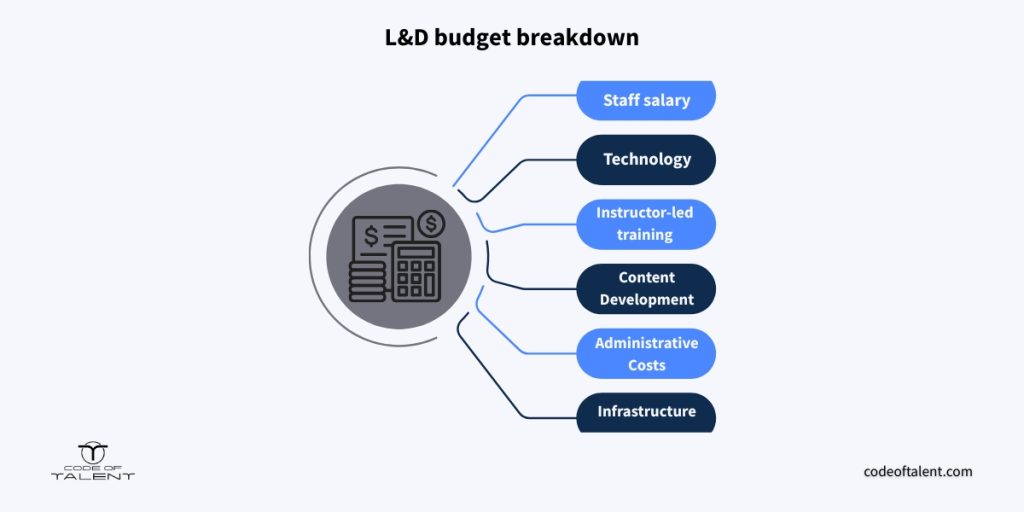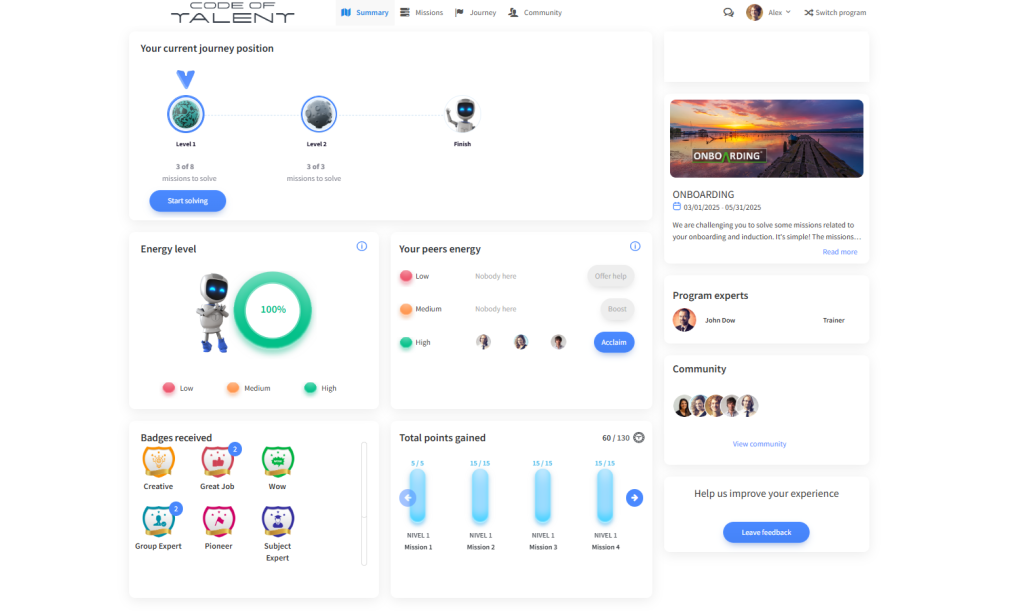Most companies invest in employee training, but few know how to structure a learning and development budget with precision or purpose.
With ongoing industry shifts such as widening skill gaps, AI integration, and rising employee disengagement, L&D budgets have experienced significant changes. According to Trainingmag:
- U.S. training expenditures fell 3.7% in 2024, dropping to $98 billion
- Payroll-related training costs declined by 4%, particularly among large enterprises
- Spending on external products and services surged 23%, reaching $12.4 billion
- Travel, facilities, and other expenses decreased from $28.7 billion in 2023 to $25 billion
Every dollar spent on training is an investment in your company’s future, but too often, L&D budgets aren’t connected to business goals or results. The most effective organizations see their L&D budgets as strategic tools that support real outcomes. This article will explore how to build and manage a learning and development budget that truly works.
What Is a Learning and Development Budget?
A learning and development budget represents the total investment a company allocates toward employee training, with all of its areas of interest, from onboarding to compliance training. It covers a wide range of expenses aimed at improving workforce skills and organizational growth.
This budget typically includes both internal costs (e.g. payroll for trainers and the use of company facilities) and external investments (e.g. software licenses, consulting services, and e-learning platforms).
Why Calculating Training Costs Is Critical

Here’s why taking the time to calculate your learning and development budget matters:
Aligns L&D with Business Goals
To have a real impact, your learning and development budget needs to be aligned with business goals. That means training should go beyond fulfilling regulatory requirements and actively support growth.
A well-structured L&D budget should be tied to key business metrics like:
- Productivity
- Customer satisfaction
- Employee retention
- Innovation.
Without visibility into training costs, it’s difficult to track ROI or understand which initiatives are delivering real value.
Supports Continuous Learning
LinkedIn’s 2024 Workplace Learning Report found that 91% of L&D professionals believe ongoing learning is essential for long-term career success. Still, many companies underfund it often because the budget isn’t clearly tied to measurable business benefits.
Responds to Rapid Change
According to the World Economic Forum, 44% of core skills will change by 2028, and half of the workforce will require reskilling due to AI and automation. A forward-looking learning and development budget helps your company stay prepared and adapt to these changes.
Prevents Budget Overruns
Without careful budgeting, training costs can quickly spiral out of control. This might lead to financial issues and the possible cancellation of future L&D projects. A budget prevents this by:
- Keeping evidence of all spendings
- Ensuring sufficient investment
- Uncovering hidden costs early
Secures Executives’ Trust
A clear learning and development budget helps gain the trust and support of company leaders. When you show exactly how the money is spent and what results it brings, executives see that L&D is important for the business’s success, not just an extra cost.
This makes it easier to ask for new tools, programs, or partnerships. It also builds trust with finance and HR teams, who are more likely to back L&D when they see the budget connected to real business goals.
Breaking Down Your Learning and Development Budget
Creating an effective learning and development budget means understanding where your money goes. Here’s a breakdown of the main cost categories to consider:

Category | What it includes | Things to Consider |
L&D Staff Salary | Salaries for the entire L&D department: trainers, instructional designers, managers, coordinators, support staff | The full team is essential for planning and running training programs; a major budget item |
Technology & Platforms | Learning management systems (LMS), VR tools, AI-powered platforms, analytics tools, etc. | Investing in innovative tools can improve engagement but may increase upfront costs |
Instructor-Led Training | In-house facilitators or outsourced external trainers | Outsourcing adds expertise but often at a higher cost |
Content Development | Custom training modules vs. off-the-shelf content | Custom content is costlier but usually more relevant and tailored |
Administrative Costs | Coordination, scheduling, compliance tasks | Often overlooked but crucial for smooth program delivery |
Infrastructure | Equipment, travel, office space | Many companies are reducing these costs by shifting to virtual or hybrid learning |
The True Costs of Training Employees: What Most Companies Overlook
When planning your learning and development budget, it’s important to account for costs beyond just the obvious expenses. Many companies underestimate the full impact training has on the business.
Opportunity Cost of Time Off Work
Training pulls employees away from their regular duties, which can mean lost productivity and revenue. It’s helpful to estimate the average revenue lost per hour of training to get a clearer picture of this hidden cost.
Ramp-Up Time Post-Training
After training, employees often need time to apply new skills effectively. This ramp-up period can temporarily affect productivity, adding to the real cost of learning initiatives.
Employee Turnover After Investment
Employee retention is critical when budgeting for training. A study by the Society for Human Resource Management shows that replacing and training a new employee can cost 6-9 months’ worth of that employee’s salary. This means losing a trained employee not only wastes training dollars but also adds significant replacement costs.
How to Accurately Calculate Training Costs
To build a sustainable and effective learning and development budget, you need more than a list of costs. You need a practical framework that helps you make tradeoffs, plan for growth, and tie training directly to outcomes. Here’s how to do it.
Fixed vs. Variable Costs: Plan Smarter, Not Just Bigger
One of the most important distinctions in L&D budgeting is between fixed and variable costs. Understanding the difference can help you build a more responsive training operation.
Fixed Costs
Fixed costs are expenses that stay consistent regardless of how many employees you train. These typically include:
- Learning platforms (e.g., LMS, microlearning tools)
- Content libraries and annual license renewals
- Salaries for L&D staff and leadership
- Compliance and tracking tools
- Software subscriptions and ongoing vendor contracts
Action plan for fixed costs:
- List all recurring costs associated with your L&D infrastructure
- Use this to establish your annual baseline budget
- Divide total fixed costs by your projected learner base to get a per-employee figure
Example: If your LMS costs $24,000 annually and supports 600 employees, the fixed cost per learner is $40/year, which is a useful benchmark for tracking ROI later on.
Variable Costs
Variable costs fluctuate depending on the size and structure of your programs. They change with how many learners you train, which formats you use, and whether your sessions are delivered in-person or online. These costs are harder to control, but they’re also where you have the most room to optimize.
Examples include:
- External facilitators and consultants
- Custom content development or translation
- Printed materials, assessments, per-seat license fees
- Travel, meals, venue bookings for in-person training
- Costs for covering employee time off (backfill, overtime)
Action plan for variable costs:
- Model three budget scenarios: conservative, expected, and high-growth
- Forecast variable costs per program to identify cost drivers
- Explore bulk discounts or digital-first alternatives to reduce spend
Example: Forecasting Training Costs Across Scenarios
Use a simple spreadsheet like this to map out cost expectations by scenario:
Program | Scenario | Participants | Cost/learner | Total cost |
Leadership 101 | Conservative | 30 | $300 | $9,000 |
Expected | 50 | $300 | $15,000 | |
High-Growth | 80 | $300 | $24,000 |
Use a Training ROI Calculator
Budget conversations often hit a wall when leadership asks: “What do we get in return?” That’s why calculating training ROI is essential, not just for proving value, but for improving it.
Action plan:
- Add up your total investment: fixed + variable costs
- Estimate the benefits: faster onboarding, reduced turnover, increased productivity
Apply this formula:
ROI (%) = (Training Benefit – Training Cost) / Training Cost × 100

Additional tip: include these metrics
- Time to productivity (shorter ramp-up = faster value)
- Fewer errors, rework, or customer escalations
- Higher retention rates, especially after key programs
- Employee engagement metrics linked to development opportunities
Annual vs. Per-Employee Budgeting
The scale and structure of your training programs directly influence how you budget. Choosing between an annual and a per-employee budgeting model (or using both strategically) can make your learning and development budget more effective and easier to manage.
Annual Budgeting For Forecasting and Control
An annual budget gives you a fixed pool of resources to work with across the year. It’s ideal for:
- Long-term planning
- Organizations with fixed budget cycles
- Large, strategic initiatives that require upfront investment
Tip: Build a 10–15% buffer into your yearly budget to cover unplanned costs, like regulatory updates or new technology.
Per-Employee Budgeting For Flexibility and Customization
This model assigns a specific amount of learning investment per employee and allows you to scale based on headcount. It’s especially best for:
- Agile teams with evolving needs
- Organizations with diverse roles or locations
- Supporting personalization in learning
Tip:
- Use tiered budgeting (e.g., $500 for entry-level, $1,500 for mid-level, $3,000 for leadership)
- Tie individual budgets to performance goals and development plans
Which Should You Use?
Many companies benefit from using both: annual budgeting for infrastructure and core programs and per-employee budgeting for personalized or team-level learning. The right mix depends on your company’s size, goals, and financial structure.
Tighten Your Learning and Development Budget: A Smarter, Leaner Approach
No budget is perfect, but with the right system in place, you can eliminate waste, double down on what works, and make every dollar count. Use this plan to make your L&D spending leaner, smarter, and more aligned with business goals.

Step 1: Gather the right data
Start with full visibility. Collect key metrics like participation rates, training hours, program costs, completion rates, and post-training performance. Without this data, you’re budgeting blind.
Step 2: Analyze what’s working and what’s not
Use your data to identify which programs actually improve performance, retention, or employee engagement. Look at outcomes, not just satisfaction scores. If a program isn’t delivering, it’s time to question its place in the budget.
Step 3: Eliminate or rework costly investments
Not every underperforming program needs to be scrapped; some just need a smarter approach. Review what’s not delivering results, then decide whether to cut it entirely or optimize it.
That could mean switching to using an LMS, in-house facilitators, or simplifying content. Reinvest savings into programs that show stronger ROI.
Step 4: Prioritize high-impact training
Focus first on training tied to business-critical outcomes such as leadership development, sales enablement, compliance, or onboarding. These programs have the highest potential to move the needle.
Step 5: Start small with pilot programs
Before rolling out expensive company-wide initiatives, test them in one team, region, or business unit. Track engagement, outcomes, and scalability and scale only what works.
Step 6: Review quarterly and refine
Set up regular checkpoints to track KPIs and get feedback from learners, managers, HR, and finance. Shift resources based on what’s delivering results and what isn’t.
Maximizing ROI: Cost-Effective Strategies for L&D Success
Getting the most value from your learning and development budget doesn’t always mean spending more, but spending smarter. With tighter resources and increasing demands for results, cost-effective strategies can help you improve outcomes without overspending.
Switch to Microlearning for Efficiency
Short, focused learning sessions—also known as microlearning—are not only easier to create and distribute but also more effective. With microlearning, L&D teams can:
- Lower production costs: Microlearning requires fewer resources than traditional long-form training. Costs like venue rental, external trainers, and manual content updates are significantly reduced or eliminated thanks to platforms with built-in features such as AI-generated modules, mobile and desktop access, and easy deployment.
- Better learner engagement: Bite-sized content fits into daily workflows and is easier to complete. Moreover, most microlearning platforms integrate engaging features and formats such as gamification to make the experience better for the learners.
- Proven results: A 2024 study in the Journal of Learning for Development found that MBA students using microlearning outperformed traditional learners, with higher test scores, greater satisfaction, and lower cognitive load.
Consolidate Training Tools
Juggling multiple tools can lead to fragmented experiences, integration issues, and hidden costs. Using only one platform:
- Reduces redundancy: Eliminate overlapping software and simplify tech support.
- Streamlines data: Centralized platforms make it easier to track performance and ROI.
- Improves user experience: Learners and admins benefit from an all-in-one environment.
- Is cost effective: Investing in one platform that addresses all your needs reduces additional costs on multiple other platforms or subscriptions.
Adapting Your L&D Budget to Industry Needs
Not all industries have the same training needs or the same budget realities. Customizing your learning and development budget based on your sector’s pace is a requirement for driving real results.
Hospitality: Train Fast, at Scale, and On the Floor
In hospitality, high employee turnover, seasonal staffing, and customer-facing roles demand quick, practical, and scalable training solutions.
Tips for Budgeting in Hospitality:
- Prioritize microlearning to deliver training in short bursts between shifts or during onboarding.
- Budget for multilingual content, especially for diverse or global teams.
- Include mobile-first delivery platforms in your fixed costs so training fits into frontline workflows.
- Invest in developing customer service skills such as communication, empathy, and time management.
Healthcare: Budget for Compliance and Lifelong Learning
With strict regulations and continuous advances in medical practices, healthcare organizations must budget for both compliance training and upskilling.
Tips:
- Set a recurring budget line for compliance-related certifications and reporting tools.
- Forecast variable costs for rotating staff and external trainers.
- Use ROI models that include patient satisfaction and error reduction as impact metrics.
Tech & SaaS: Stay Ahead of Rapid Change
In fast-paced tech environments, continuous learning is key to maintaining a competitive edge.
Tips:
- Focus budgets on just-in-time training, peer-to-peer knowledge sharing, and agile upskilling.
- Align L&D spending with product and engineering roadmaps.
- Use per-employee budgeting to offer learning stipends tied to role maturity or specialization.
The Smart Way Forward: One Platform, Microlearning-First
To make every dollar of your learning and development budget count, choose a solution that combines agility with insight. Look for a platform that supports:
- Microlearning by design
- Mobile-first delivery
- Real-time analytics
- Easy integration with your HR and business tools
- Gamification for engagement
- Easy deployment methods
Code of Talent is a modern microlearning platform built to help companies reduce costs, scale faster, and prove impact. With its modular structure and performance tracking, it’s designed for teams that want to do more with less.

With the right approach, your learning and development budget becomes a tool for growth, not just an expense. Try Code of Talent for free and see how microlearning can help you deliver faster, smarter, and more impactful training at scale.
Cover photo: Freepik





